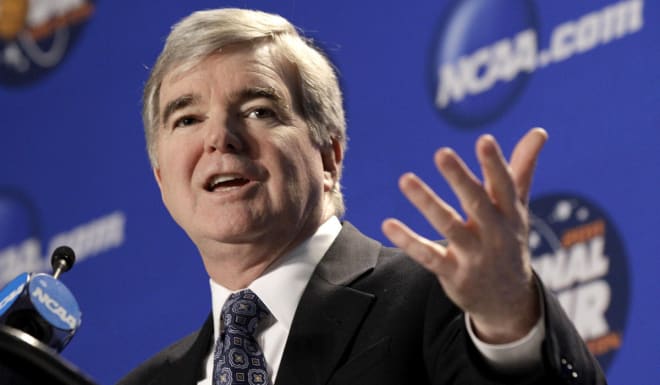NCAA president discusses major topics affecting college athletics


Ninety-two percent of the NCAA’s total revenues are derived from a singular event – the NCAA Men’s Basketball Tournament a/k/a March Madness. Along with that, Division I athletes are feeling increasing pressure from many sides – mainly coaches, fans and the media – to perform and practice at a high level year-round.
NCAA president Mark Emmert says both are major concerns for his organization.
The continuing decline of basic cable has many college sports executive (and pro sports as well) feeling anxious about an uncertain future. Today, younger fans consume media across a broader spectrum, and have a wider array of choices than fans did 20 or 30 years ago.
As a result, behemoth media companies such as ESPN and the over-the-air networks rare supposedly feeling the financial pinch as the internet expands every day and offers alternative avenues to watch sports.
What does the future hold for Division I athletics from a television and media consumption perspective? Opinions vary, and concerns are rising.
“It’s clear media consumption in all its forms is changing pretty significantly,” Emmert told the Intercollegiate Athletics Committee on Friday. “There is a lot of disruption going on in that business world. You see it with the valuation of the big media companies in the stock market since August.
“There are a lot of questions about what this all will look like in three, five or 10 years. Young people particularly consume all forms of media in very different ways than (older people). That will create both opportunities and challenges for the NCAA. It is a fascinating moment.
ESPN has lost over 2 million subscribers in the last year alone, Emmert said.
The billions of dollars generated from March Madness essentially support all of the NCAA’s operations. Emmert acknowledged he would prefer greater diversity in the NCAA’s revenue base.
“We’d love it to be (more diverse)”, Emmert said. “We’re focused on putting on 90 great championships. Revenue from the men’s basketball tournament supports a lot of different things. Half of the money goes straight back to the universities themselves. Another $100 million goes towards a fund for students to supply them with the things they need personally.
“Yes, we would of course like it to be more diversified, but it is the dominant source and the men’s basketball tournament has become a wonderful iconic event. It works well.”
As the pressure to win keeps building, athletes are feeling the heat from coaches to devote more and more time to their craft.
Latest example? Michigan plans to hold football workouts in Florida over spring break, robbing time off from the players.
“The time demands being placed upon student-athletes are just enormous,” Emmert said. “They are having a hard time being students. Our meeting in April will focus on how we can change the rules to give students more time to be students, and relive some of the stress they are feeling.
“But that is easier said than done. Everybody wants to win and they are all competitors. We have to make sure there continues to be that student-university relationship that makes college sports so special. We are trying to find ways to dial back the demands on student-athletes and not ramp them up.”
Too late for the NCAA to do anything about Michigan’s plans this year, but the issue will certainly come up when the NCAA Board of Directors meet in April.
Board of Trustees member Chuck Allen, a former Gamecock football player, described Michigan’s spring break tactic as “misguided.” The NCAA Football Oversight Committee has already said they will quickly consider the issue, Emmert told the IAC.
“Nothing (Michigan) is doing is against the rules, so if the membership wants to change the rules, they need to do so,” Emmert said. “There is a lot of interest right now to make sure we are providing student-athletes with the time they need to be regular students as well as athletes.
“There is big debate going on right now about how to provide more time off for student-athletes. The use of spring break for football practices has caused a lot of people to be concerned about it. That is an appropriate concern. The Football Oversight Committee will look at it and perhaps recommend a rule change.”
NOTES
-- Ray Tanner told the Intercollegiate Athletics Committee that South Carolina is the only school in the country in which both the men’s and women’s basketball teams average more than 11,000 fans per game. Averaging more than 14,500 fans per game, the Gamecock women’s team tops the country in attendance. USC is fifth in the SEC in men’s basketball attendance and had a 40 percent increase in season ticket sales.
-- The combined 46-6 record of the men’s and women’s basketball teams is best in the country, Tanner said.
-- Average football attendance in 2015 was about 78,800 fans for seven home games, Tanner said.
-- Emmert said graduation rates of student-athletes across the country surpass the rates of the general student population. Unfortunately, Emmert lamented the ‘dumb jock’ stereotype (myth?) still permeates throughout society, so people are often astounded by the actual statistics. Specifically, the graduation rates of both male and female African-American student athletes are more than 12 percent higher than general African-American students.
-- Emmert spent two days on campus meeting with USC administrators and athletes. “You have some marvelous people here,” Emmert said. “The student group I met with covered all the sports and were remarkable. They were not shy with their opinions and views.”